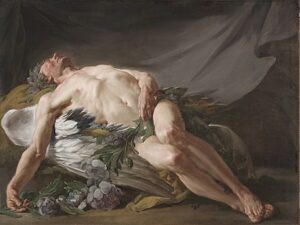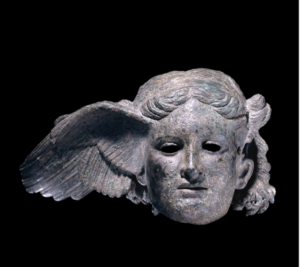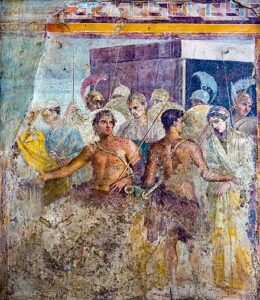The ancient Greeks expressed their view of the origin and nature of the world through their mythology. It referred to the lives and activities of the deities, heroes, and mythological creatures as well as the origins and significance of the ancient Greeks’ cult and ritual practices.
Morpheus (Greek: Μορφέας) is one such mythological figure. His name means ‘Fashioner’, from the Greek ‘μορφή’, meaning ‘form, shape’. He is the god of sleep and dreams; a god associated with a third of our life. He appears in dreams in human form bearing messages from the gods as well as appearing to the Olympian gods. He is the son of Hypnos (Greek: Ύπνος – God of Sleep) and Pasithea (Greek: – Goddess of relaxation and rest). His grandmother was Nyx (Greek: Νυξ) the fearsome deity of Night. His uncle was Thanatos (Greek: Θάνατος), the god of death. Only the Olympian Gods could visit Morpheus and his family in the land of dreams.

Morpheus painted by Jean Bernard Restout (Paris – 1771)
His brothers were Icelus (meaning ‘like’), who made the dreams seem real; Phobetor was responsible for phobic or terrifying dreams, and Phantasus created fantastic and surreal dreams. Morpheus was their leader, and he alone was able to oversee the dreams of Gods, kings, and heroes. This is what set him apart from his brothers. They emerged each night like a flock of bats from Erebos, their cavernous home, the land of eternal darkness in the West, where the sun sets (Greek: Δύση). They would pass through two gates: one made of horn and the other of ivory. Morpheus would pass through the gate made of horn, which represented true or divine dreams. His brothers would pass through the ivory gate, which represented dreams without true meaning. These gates were guarded by two monsters to prevent anyone from entering. Beyond the gates were the River of Forgetfulness and the River of Oblivion.

Morpheus was a winged being. He had two wings on his back, which allowed him to travel noiselessly great distances and at great speed. He is also depicted with a winged ear, symbolizing his listening to, and delivering of dreams. He listens through his normal ear and uses his winged ear to deliver the messages to the receiver, whether it be the Gods or mortals. The Greek gods used him as their messenger to appear in the dreams of the mortals and in this way, to liberate the desires, hopes, and imaginations of the sleeper. However, dreams can also portray false realities, and so betray the receiver to act in an unforeseeable way.
 Morpheus is used in such a way in Homer’s Iliad to deliver a message from Zeus to King Agamemnon, king of Mycenae and the leader of the Greek army in the war against Troy. This false dream was sent by Zeus to Agamemnon in the guise of Nestor, a trusted comrade, to persuade him that if he launched a full-scale assault on Troy, he would be successful. Zeus is misleading Agamemnon because he owes a favour to Achille’s mother, the goddess Thetis, who supports Troy and wants the defeat of the Greeks, but also wants to show the importance of Achilles’ participation in the war. After several days of fighting, the Achaeans are pushed back to their fortifications around their ships. The defeat of the Greek forces wanted to show Agamemnon that he was not the greatest of leaders and that it was Achilles who deserves to be the leader. Achilles had not taken part in this attack due to the disagreement between Agamemnon and Achilles over Briseis, a Trojan captive. Achilles was forced to give her to Agamemnon as compensation for the freeing of Chryseis, the daughter of one of Apollo’s priests, who had been taken as a war prize by Agamemnon.
Morpheus is used in such a way in Homer’s Iliad to deliver a message from Zeus to King Agamemnon, king of Mycenae and the leader of the Greek army in the war against Troy. This false dream was sent by Zeus to Agamemnon in the guise of Nestor, a trusted comrade, to persuade him that if he launched a full-scale assault on Troy, he would be successful. Zeus is misleading Agamemnon because he owes a favour to Achille’s mother, the goddess Thetis, who supports Troy and wants the defeat of the Greeks, but also wants to show the importance of Achilles’ participation in the war. After several days of fighting, the Achaeans are pushed back to their fortifications around their ships. The defeat of the Greek forces wanted to show Agamemnon that he was not the greatest of leaders and that it was Achilles who deserves to be the leader. Achilles had not taken part in this attack due to the disagreement between Agamemnon and Achilles over Briseis, a Trojan captive. Achilles was forced to give her to Agamemnon as compensation for the freeing of Chryseis, the daughter of one of Apollo’s priests, who had been taken as a war prize by Agamemnon.
The wall painting showing Achilles surrendering Briseis to Agamemnon found in the house of the tragic poet in Pompei, which dates to 1st c. A.D., is now in the National Archaeological Museum in Naples.
The reference to Morpheus to express the state of dreaming and as a messenger has been used by many poets from antiquity up to the present times. One such poet is Ovid, the Roman poet (43 BC – 17/18 AD), who lived during the reign of the emperor Augustus. He uses Morpheus in his poetic work Metamorphoses to tell the story of Ceyx and his wife Alcyone, the king and queen of Trachis in Thessaly, who were transformed into birds after provoking the wrath of Zeus. Morpheus appears to Alcyone in a dream as her husband Ceyx to tell her of his death.
 Besides works of literature, there are many works of art as well as sculptures showing Morpheus in a state of sleep and as a messenger of the gods. The word ‘Morpheus’ is also used in figurative speech in sayings such as in the arms of Morpheus to express the idea of someone sleeping deeply. We also have the medical term ‘morphine’, which is connected to the poppy seeds that Morpheus had in his cave and is used for those in severe pain. Poppies have also been used to treat insomnia due to their hypnotic properties.
Besides works of literature, there are many works of art as well as sculptures showing Morpheus in a state of sleep and as a messenger of the gods. The word ‘Morpheus’ is also used in figurative speech in sayings such as in the arms of Morpheus to express the idea of someone sleeping deeply. We also have the medical term ‘morphine’, which is connected to the poppy seeds that Morpheus had in his cave and is used for those in severe pain. Poppies have also been used to treat insomnia due to their hypnotic properties.
In the film world, Morpheus is one of the main characters in the Matrix films.
Next time you dream, think as to whether Morpheus has anything to do with it!!